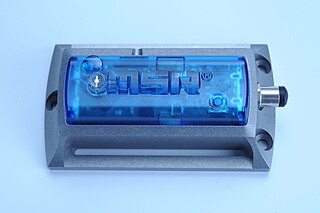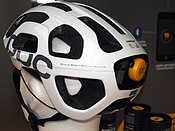
In mechanics and physics, shock is a sudden acceleration caused, for example, by impact, drop, kick, earthquake, or explosion. Shock is a transient physical excitation.

An accelerometer is a device that measures the proper acceleration of an object. Proper acceleration is the acceleration of the object relative to an observer who is in free fall. Proper acceleration is different from coordinate acceleration, which is acceleration with respect to a given coordinate system, which may or may not be accelerating. For example, an accelerometer at rest on the surface of the Earth will measure an acceleration due to Earth's gravity straight upwards of about g ≈ 9.81 m/s2. By contrast, an accelerometer that is in free fall will measure zero acceleration.

An inclinometer or clinometer is an instrument used for measuring angles of slope, elevation, or depression of an object with respect to gravity's direction. It is also known as a tilt indicator, tilt sensor, tilt meter, slope alert, slope gauge, gradient meter, gradiometer, level gauge, level meter, declinometer, and pitch & roll indicator. Clinometers measure both inclines and declines using three different units of measure: degrees, percentage points, and topos. The astrolabe is an example of an inclinometer that was used for celestial navigation and location of astronomical objects from ancient times to the Renaissance.

A security alarm is a system designed to detect intrusions, such as unauthorized entry, into a building or other areas, such as a home or school. Security alarms protect against burglary (theft) or property damage, as well as against intruders. Examples include personal systems, neighborhood security alerts, car alarms, and prison alarms.

In mechanics, an impact is when two bodies collide. During this collision, both bodies decelerate. The deceleration causes a high force or shock, applied over a short time period. A high force, over a short duration, usually causes more damage to both bodies than a lower force applied over a proportionally longer duration.
A football helmet is a type of protective headgear used mainly in gridiron football, although a structural variation has occasional use in Australian rules football. It consists of a hard plastic shell with thick padding on the inside, a face mask made of one or more plastic-coated metal bars, and a chinstrap. Each position has a different type of face mask to balance protection and visibility, and some players add polycarbonate visors to their helmets, which are used to protect their eyes from glare and impacts. Helmets are a requirement at all levels of organized football, except for non-tackle variations such as flag football. Although they are protective, players can and do still suffer head injuries such as concussions.
Condition monitoring is the process of monitoring a parameter of condition in machinery, in order to identify a significant change which is indicative of a developing fault. It is a major component of predictive maintenance. The use of condition monitoring allows maintenance to be scheduled, or other actions to be taken to prevent consequential damages and avoid its consequences. Condition monitoring has a unique benefit in that conditions that would shorten normal lifespan can be addressed before they develop into a major failure. Condition monitoring techniques are normally used on rotating equipment, auxiliary systems and other machinery like belt-driven equipment,, while periodic inspection using non-destructive testing (NDT) techniques and fit for service (FFS) evaluation are used for static plant equipment such as steam boilers, piping and heat exchangers.

Package cushioning is used to protect items during shipment. Vibration and impact shock during shipment and loading/unloading are controlled by cushioning to reduce the chance of product damage.

A checkweigher is an automatic or manual machine for checking the weight of packaged commodities. It is normally found at the offgoing end of a production process and is used to ensure that the weight of a pack of the commodity is within specified limits. Any packs that are outside the tolerance are taken out of line automatically.

The term unit load refers to the size of an assemblage into which a number of individual items are combined for ease of storage and handling, for example a pallet load represents a unit load which can be moved easily with a pallet jack or forklift truck, or a container load represents a unit for shipping purposes. A unit load can be packed tightly into a warehouse rack, intermodal container, truck or boxcars, yet can be easily broken apart at a distribution point, usually a distribution center, wholesaler, or retail store for sale to consumers or for use.
The terms active packaging, intelligent packaging, and smart packaging refer to amplified packaging systems used with foods, pharmaceuticals, and several other types of products. They help extend shelf life, monitor freshness, display information on quality, improve safety, and improve convenience.
A time temperature indicator (TTI) is a device or smart label that shows the accumulated time-temperature history of a product. Time temperature indicators are commonly used on food, pharmaceutical, and medical products to indicate exposure to excessive temperature.
Pyroshock, also known as pyrotechnic shock, is the dynamic structural shock that occurs when an explosion or impact occurs on a structure. Davie and Bateman describe it as: "Pyroshock is the response of a structure to high frequency, high-magnitude stress waves that propagate throughout the structure as a result of an explosive event such as an explosive charge to separate two stages of a multistage rocket." It is of particular relevance to the defense and aerospace industries in that they utilize many vehicles and/or components that use explosive devices to accomplish mission tasks. Examples include rocket stage separation, missile payload deployment, pilot ejection, automobile airbag inflators, etc. Of significance is the survival and integrity of the equipment after the explosive device has activated so that the vehicle can accomplish its task. There are examples of flight vehicles Boeing-The Aerospace Corp which have crashed after a routine explosive device deployment, the cause of the crash being determined as be a result of a computer failure due to the explosive device. The resultant energies are often high g-force and high frequency which can cause problems for electronic components which have small items with resonant frequencies near those induced by the pyroshock.

Package testing or packaging testing involves the measurement of a characteristic or property involved with packaging. This includes packaging materials, packaging components, primary packages, shipping containers, and unit loads, as well as the associated processes.
Riddell Revolution helmets are a line of football helmets. The helmet brand is the most popular model in use in the National Football League, used by 83% of the players in the league as of 2008. The most recent model in the Revolution line is the Speedflex helmet. This model can come equipped with Riddell's HITS Technology, which consists of a sensor in the helmet that relays data regarding the severity of each hit to a computer system. The Speedflex also features a built-in hinged panel located on the front near the top. In head-on collisions, this panel gives by up to a quarter of an inch, helping to absorb the impact.

An inertial measurement unit (IMU) is an electronic device that measures and reports a body's specific force, angular rate, and sometimes the orientation of the body, using a combination of accelerometers, gyroscopes, and sometimes magnetometers. When the magnetometer is included, IMUs are referred to as IMMUs.

A shock data logger or vibration data logger is a measurement instrument that is capable of autonomously recording shocks or vibrations over a defined period of time. Digital data is usually in the form of acceleration and time. The shock and vibration data can be retrieved, viewed and evaluated after it has been recorded.
A temperature data logger, also called temperature monitor, is a portable measurement instrument that is capable of autonomously recording temperature over a defined period of time. The digital data can be retrieved, viewed and evaluated after it has been recorded. A data logger is commonly used to monitor shipments in a cold chain and to gather temperature data from diverse field conditions.

DTS (Diversified Technical Systems) is an American manufacturer of miniature, high-shock rated, data acquisition systems and sensors for product and safety testing in extreme environments. DTS products, made in the U.S., are used in multiple industries including automotive, aerospace, military and defense, industrial, and sports and injury biomechanics. DTS was founded in 1990 by three crash test engineers: Mike Beckage, Steve Pruitt, and Tim Kippen. The company is headquartered in Seal Beach, California, with technical centers in Michigan, Europe, Japan, China, Korea, and Asia Pacific.

A tilt detector or tilt indicator is a device which indicates whether a tilt has occurred. Tilt detectors can be used on shipments of tilt sensible items to indicate whether a potentially damaging tilt have occurred. They are also used in the field of electronics or automotive on some models to detect if a change in vehicle inclination has occurred.
















